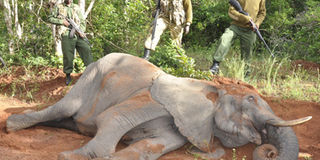Kenya's new forensic lab to help trace the origin of seized wildlife products

Kenya Wildlife Service Rangers attempt to rescue an elephant shot by poachers at Shimba Hills National Park in this file photo. FILE PHOTO | NATION MEDIA GROUP
What you need to know:
- $3 million - grant given by the US to Kenya to aid in its anti-poaching activities.
- $10 million - grant package President Barack Obama pledged in 2013 to support anti-poaching activities in Africa.
- 38,300k of ivory and 88.8kg of rhino horn have been seized at the Jomo Kenyatta International Airport and the port of Mombasa between 2010 and 2014, according to Kenya Cabinet Secretary for Environment Prof Judi Wakhungu.
Kenya is establishing a forensic laboratory to trace the origins of seized wildlife products in the East African region.
The laboratory, being constructed with the help and expertise of the US government, will be fully operational by the end of the year and will target mainly elephant tusks and rhino horns.
The decision is in line with recommendations made at the last Convention on International Trade in Endangered Species (CITES COP 16) meeting in Bangkok, Thailand, which recognised that illegal trade in elephant specimens is an international problem that requires all elephant range states and consumer states to take urgent and concerted efforts to combat it.
The meeting also highlighted the importance of addressing the entire crime chain, including determining which elephant populations are most affected by poaching.
“The forensic laboratory should be ready by end of October. What we are still lacking is the capacity to analyse elephant tusks and rhino horns.
However we are planning to have everything in place by the end of the year,” said the Environment, Water and Natural Resources Principal Secretary Richard Lesiyampe.
Mr Lesiyampe said a team of government scientists will travel to the US, in October, to study how to analyse ivory and rhino trophies.
“We will also send some samples of seized ivory trophies to the US to trace their origins. This is important since it will help us come up with effective strategies to combat poaching,” he added.
Pushing for advanced techniques
Environmentalists have been pushing for more advanced scientific techniques to combat illegal trade in wildlife products, saying international treaties are not enough.
They also argue that although the seizure of contraband is a success, investigations normally end at the point of seizure.
Thanks to advances in science, it is now possible to trace seized ivory and rhino horns back to their origins using DNA-based technology.
This, environmentalists say, can help law enforcement agencies redirect their efforts to poaching “hot spots.”
East Africa is one of the few remaining regions in the world with large elephant and rhino populations, which in the recent past have been targeted by poachers. According to Kenya Wildlife Service, the country had lost more than 20 rhinos and 55 elephants at the end of April. It is believed the situation is worse in Tanzania, since a third of all the illegal ivory seized in Asia comes from or through Tanzania.
The fight against poaching in Kenya has received a major boost from the US government, which recently donated $3 million.
“Kenya and the US have defined three key areas of intervention: Helping community conservancies build their protection mechanisms; strengthening Kenya’s investigations of wildlife trafficking crimes; and enhancing the judiciary’s ability to process wildlife trafficking cases in court,” said the US ambassador to Kenya Robert Godec.
Grant from the US
Mr Godec said the $3 million grant will be used on identified interventions. This is part of the $10 million grant package President Barack Obama pledged in 2013 to support anti-poaching activities in Africa. Of the remaining $7 million, $4 million will be spent on regional challenges facing wildlife conservation on the continent while the rest ($3 million) will be donated to South Africa, which boasts the highest rhino population in Africa.
Kenya’s Environment Cabinet Secretary Prof Judi Wakhungu, said Kenya had become a transit point for trafficking of contraband trophies due to its strategic geographical location.
“Through our efforts, 38,300kg of ivory and 88.8kg of rhino horn have been seized at the Jomo Kenyatta International Airport and the port of Mombasa between 2010 and 2014,” said Prof Wakhungu.
Go to the East African to read the full story.




